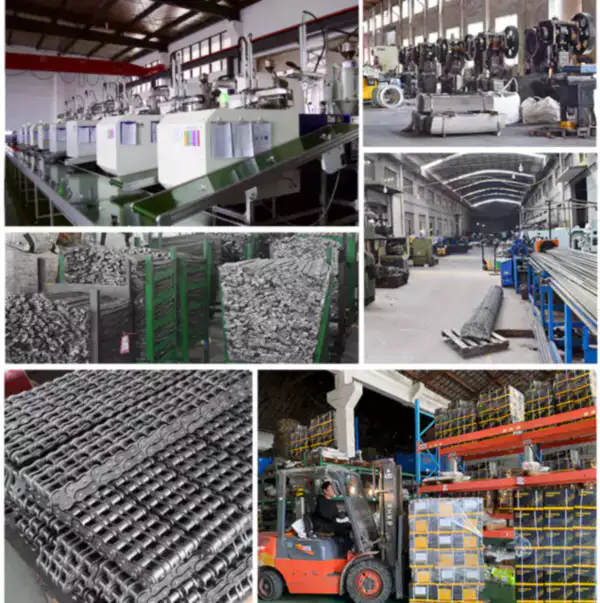Introduction
Gripper chains are essential components in various industrial applications. This article will explore the potential use of gripper chains in vertical conveying applications, highlighting their benefits and considerations.
1. Understanding Gripper Chains
Gripper chains, also known as clamping chains, are specialized chains designed to securely grip and transport objects during conveying operations. These chains are commonly used in horizontal conveying systems but can also be utilized in vertical applications.

2. Gripper Chain Construction
Gripper chains consist of interconnected links with built-in gripping mechanisms, such as clamps or jaws. These gripping elements firmly hold the transported objects, preventing slippage and ensuring a stable conveyance. The chain's design and material selection are crucial factors in determining its suitability for vertical conveying applications.
3. Considerations for Vertical Conveying
When using gripper chains in vertical conveying applications, several considerations should be taken into account:
- Load capacity: Gripper chains should be selected based on the weight and dimensions of the objects to be transported.
- Chain pitch: The pitch, or distance between chain links, affects the chain's ability to grip and transport objects effectively. It must be chosen carefully to ensure optimal performance.
- Vertical acceleration and deceleration: The speed at which the objects are lifted or lowered impacts the chain's stability and gripping force. Proper adjustment and control are necessary to prevent jerking or slipping.
- Environmental factors: Vertical conveying often involves exposure to dust, moisture, or extreme temperatures. Gripper chains must be resistant to these conditions to ensure long-lasting performance.
- Maintenance and lubrication: Regular maintenance and lubrication are crucial for preserving the chain's functionality and preventing premature wear or failure.

4. Gripper Chain Selection
Choosing the right gripper chain for a vertical conveying application requires careful analysis of the specific requirements and constraints. Factors to consider include:
- Chain material: Different materials offer varying levels of strength, corrosion resistance, and temperature tolerance. Select the material that best suits the operating conditions.
- Gripping mechanism: Evaluate the design and gripping force of the chain's clamps or jaws to ensure compatibility with the objects being conveyed.
- Chain speed: Determine the required conveying speed and select a gripper chain capable of handling the desired velocity without compromising safety or efficiency.
- Chain length and configuration: Consider the length and layout of the conveying system to determine the appropriate chain length and any necessary customization.
Overall, proper gripper chain selection is crucial for ensuring smooth and reliable vertical conveying operations.
5. Gripper Chain Procurement Guide
| Parameter | Considerations |
|---|---|
| Load Capacity | Determine the maximum weight the chain needs to support for efficient conveying. |
| Chain Pitch | Select the appropriate pitch size based on the application requirements and object dimensions. |
| Material | Choose the chain material that provides optimal strength and durability for the operating conditions. |
| Gripping Mechanism | Ensure the chain's clamps or jaws are suitable for securely holding the objects during vertical conveying. |
| Maintenance Needs | Consider the maintenance requirements and availability of spare parts for long-term reliability. |
Sprockets for Gripper Chains
Gripper chains and sprockets are inseparable components in conveying systems. A properly matched sprocket ensures smooth engagement and precise movement of the gripper chain. The sprocket's teeth should align with the chain's links, allowing efficient power transmission and reducing wear on both components. Our company offers a wide range of sprockets specifically designed for gripper chains, ensuring optimal performance and compatibility.

Our sprockets are engineered to complement gripper chains, offering excellent durability and precise engagement. With various tooth profiles and materials available, we can provide customized sprockets to meet specific application requirements.
Our Advantages
Choosing us as your gripper chain supplier offers several advantages:
- Extensive industry experience and expertise in gripper chain manufacturing.
- High-quality materials ensuring superior strength and longevity.
- Customizable solutions tailored to meet unique application requirements.
- Prompt and reliable customer support for technical assistance and inquiries.
- Competitive pricing and on-time delivery for cost-effective and efficient operations.

Q&A – Gripper Chains
Q: Can gripper chains be used for fragile objects?
A: Gripper chains can be used for fragile objects, but careful consideration must be given to the gripping mechanism and the object's susceptibility to damage. Proper padding or protective measures may be necessary.
Q: Are gripper chains suitable for high-speed conveying?
A: Gripper chains can be used for high-speed conveying, but factors like chain pitch, gripping force, and object stability should be carefully assessed to ensure safe and efficient operation.
Q: How often should gripper chains be lubricated?
A: Lubrication frequency depends on various factors such as operating conditions, chain speed, and load. Regular inspections should be conducted, and lubrication should be performed as recommended by the manufacturer.
Edited by Zqq.
